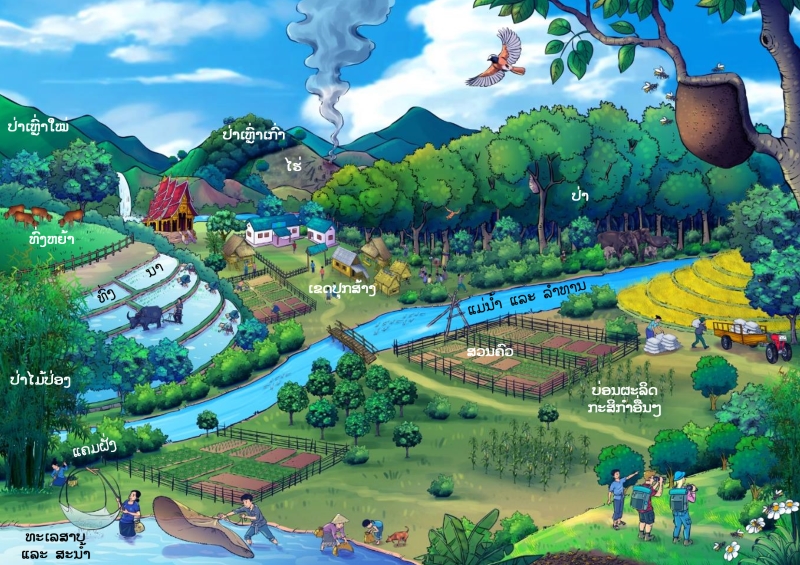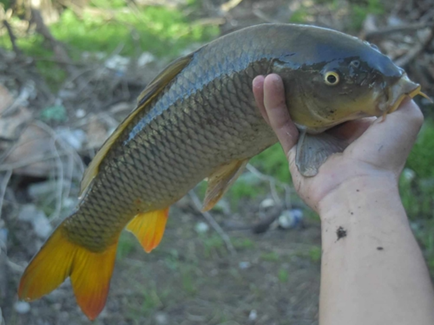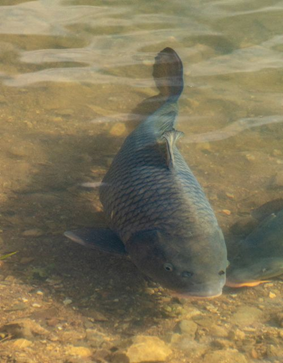ເລກລຳດັບທີ: 3853
ລະດັບການຮວບຮວມຂໍ້ມູນ: ຂໍ້ມູນລະອຽດ
ປັບປູງຄັ້ງລ່າສຸດ: 2024-10-14
ປາໄນ
Eurasian Carp
Cyprinus carpio Linnaeus, 1758
ສັດ
ປາ
×
ຊື່ທ້ອງຖີ່ນ:
( Aischgrund Carp, Common carp)
ຊື່ພ້ອງ
:
Cyprinus cirrosus Schaeffer, 1760
Cyprinus viri-violaceus Lacepède, 1803
Cyprinus rubrofuscus
Cyprinus nigroauratus.
Cyprinus vittatus Cuvier & Valenciennes, 1842
Cyprinus conirostris Schelegel, 1842,
Cyprinus haematopterus.
Cyprinus acuminatus Richardson, 1846
Cyprinus sculponeatus
Cyprinus flamm
Cyprinus atrovirens.
Cyprinus melanotus Schelegel, 1846
Carpio vulgaris Rapp, 1854
Cyprinus chinensis Basilewsky, 1855
Carpio flavipinna Bleeker, 1863
Cyprinus tossicole Elera, 1895
Cyprinus viri-violaceus Lacepède, 1803
Cyprinus rubrofuscus
Cyprinus nigroauratus.
Cyprinus vittatus Cuvier & Valenciennes, 1842
Cyprinus conirostris Schelegel, 1842,
Cyprinus haematopterus.
Cyprinus acuminatus Richardson, 1846
Cyprinus sculponeatus
Cyprinus flamm
Cyprinus atrovirens.
Cyprinus melanotus Schelegel, 1846
Carpio vulgaris Rapp, 1854
Cyprinus chinensis Basilewsky, 1855
Carpio flavipinna Bleeker, 1863
Cyprinus tossicole Elera, 1895
ຊື່ສະກຸນ:
Cyprinidae
ຊະນິດໃກ້ຄຽງ:
ປາແຝກ / Goldfish
ປາຫົວແງນນ້ອຍ/ ປາຫົວແງນນ້ອຍ
ປາກິນຫຍ້າ/ Grass Carp
ປາຫົວແງນນ້ອຍ/ ປາຫົວແງນນ້ອຍ
ປາກິນຫຍ້າ/ Grass Carp
ບັນຍາຍລັກສະນະທາງພືດສາດ:
ປາຊະນິດນີ້ມີຮູບຮ່າງຍາວ, ແປເລັກນ້ອຍ ແລະ ມີຮິມຝີປາກໜາ, ມີໜວດສອງຄູ່ຢູ່ທີ່ມຸມປາກ ໂດຍໜວດບໍລິເວນຮິມຝີປາກດ້ານເທິງຈະສັນກວ່າ, ຄີຫລັງ (ຄີດ້ານເທິງ) ມີຖານຍາວໂດຍມີກ້ານຄີປະມານ 17-22 ກ້ານ ແລະ ກະດູກສັ້ນຫຼັງມີຄວາມແຂງແຮງຄື ກັບແຂ້ວທີ່ຢູ່ດ້ານໜ້າ, ໂຄງສ້າງຂອງຄີດ້ານໜ້າຈະໂຄ້ງເຂົ້າໃນ, ຄີທະວານ (ຄີລຸ້ມ) ມີກ້ານຄີອ່ອນ 6-7 ກ້ານ ແລະ ກ້ານຄີອັນທີ່ສາມຂອງຄີຫຼັງ ແລະ ຄີກົ້ນມີປຸ່ມແຫຼມນ້ອຍໆບໍລິເວນຫຼັງກ້ານຄີ. ມີເກັດຂ້າງລຳຕົວ 32 ຫາ 38 ອັນ, ມີແຂ້ວ 10 ເຫລັມຢູ່ໃນຄໍ. ສີຂອງປາຈະມີຄວາມແຕກຕ່າງກັນໂດຍປົກກະຕິເເລ້ວຄີຫຼັງ ແລະ ລຳຕົວສົນເທິງຈະເປັນສີນ້ຳຕານ ຫຼື ສີຂຽວ, ບໍລິເວນລຳຕົວສ່ວນລຸ່ມຈະເປັນສີເຫຼືອງທອງ, ຄີດ້ານລຸ່ມຈະເປັນສີຄ້ຳ ຫຼື ສີແດງ [4].
ປາໄນມັກຈະວາງໄຂ່ຢູ່ຕາມແຄມຝັ່ງ ຫຼື ແຫຼ່ງນ້ຳຕື້ນ, ຕົວອ່ອນຂອງປາຊະນິດນີ້ຕ້ອງການນ້ຳອຸ່ນ ແລະ ພືດທີ່ຢູ່ໃນນ້ຳເພື່ອຄວາມຢູ່ລອດ. ໂດຍປົກກະຕິແລ້ວ ປາເພດຜູ້ຈະເລີ່ມປະສົມພັນຕອນອາຍຸ 3 ຫາ 5 ປີ ໃນຂະນະທີ່ເພດແມ່ຈະເລີ່ມປະສົມພັນເມື່ອອາຍຸ 4 ຫາ 6 ປີ. ປາຊະນິດນີ້ສາມາດມີອາຍຸຢູ່ໄດ້ຮອດ 50 ປີ ແລະ ມັກຈະວາງໄຂໃນທຸກໆປີ ໄລຍະຂອງການວາງໄຂ່ຈະໄດ້ຮັບອິດທິຜົນຈາກເສັ້ນຂະຫນານ ແລະ ຄວາມສູງ, ໂດຍຈະເກີດຂື້ນໃນພືດສະພາ ຫາ ເດືອນມີຖຸນາ ເມື່ອອຸ່ນຫະພູມນ້ຳສູງກ່ວາ 18 ອົງສາ. ຝູງປາໄນທີ່ໃຫ່ຍເຕັມໄຫວມັກຈະອົບພະຍົບເປັນໄລຍະທາງທີ່ໄກເພື່ອໄປຫາແຫຼ່ງນ້ຳນິ້ງ ຫຼື ເຂດທົ່ງຫຍ້າທີ່ມີນ້ຳຖ້ວມຂັງທີເໝາະສົມເພື່ອວາງໄຂ່, ປາເພດແມ່ຈະວາງໄຂ່ໜຽວໃນພືດນ້ຳທີ່ມີຄວາມໜາແໜ້ນ ຊຶ່ງໄຂ່ຈະໄດ້ຮັບການປະສົມພັນຈາກປາຕົວຜູ້. ໂຕອ່ອນຂອງປາໄນມັກອາໄສຢູ່ບ່ອນທີ່ມີອຸ່ນຫະພູມອົບອຸ່ນ, ນ້ຳຕື່ນ ແລະ ເຂດນ້ຳຖ້ວມຂັງ, ໂດຍກິນສັດນ້ອຍໆເປັນອາຫານໂດຍສະເພາະແມ່ນແພຼງຕ່ອນສັດເປັນຫຼັກ ເຊັ່ນ: rotifers. ການປະສົມພັນຈະປະສົບຜົນສຳເລັດ ແມ່ນຂື້ນຢູ່ກັບລະດັບນ້ຳທີ່ສູງຂື້ນ, ອຸ່ນຫະພູມທີ່ສູງ ແລະ ຫຍ້າທີ່ຖືກນ້ຳຖວ້ມເວລາດົນໃນຊ່ວງເດືອນ ພຶດສະພາ ຫາ ເດືອນມີຖຸນາ. ໃນປະເທດລາວ ລະດູປະສົມພັນຂອງພວກມັນຈະຕົງກັບຊ່ວງລະດູຝົນໂດຍເລີ່ມແຕ່ ເດືອນພຶດສະພາ ຈົນຮອດ ເດືອນຕຸລາ ເຊິ່ງເປັນຊ່ວງທີ່ອຸ່ນຫະພູມຂອງນ້ຳ ແລະ ກະແສນ້ຳທີ່ເພີ່ມຂື້ນ, ເຮັດໃຫ້ປາໄນສາມາດອົບພະຍົບໄປຕົ້ນນ້ຳເພື່ອຊອກຫາບ່ອນວາງໄຂ່ທີ່ເໝາະສົມ. ຕົວອ່ອນ ແລະ ຕົວເຕັມໄວມັກຈະກິນສິ່ງທີ່ມີຊີວິດຢູ່ພື້ນດິນ ແລະ ພືດທີ່ຫຼາກຫຼາຍຊະນິດ ແລະ ພວກມັນຈະເຄື່ອນໄຫວຫຼາຍທີ່ສຸດໃນຊວ່ງເວລາກາງຄືນ ແລະ ຊ່ວງທີ່ໃກ້ຈະເຊົ້າ. [5]
ການຟັກໄຂ່: ໄຂ່ປາໄນທົ່ວໄປຈະໜຽວ ແລະ ເກາະຕິດກັບວັດຖຸຕ່າງໃນສະພາບແວດລ້ອມຂອງມັນ, ໄຂ່ເຫຼົ່ານີ້ມັກຈະຟັກໃນອ່າງຊີມັງ ຫຼື ໃນຫນອງນ້ຳ ໂດຍຊີດນ້ຳເພື່ອປ້ອງກັນບໍ່ໃຫ້ໄຂ່ມັນແຫ້ງ. ແຕ່ເຖິງແນວໃດກໍຕາມການຟັງໄຂ່ຍັງສາມາດເກີດຂື້ນໄດ້ຢູ່ໃນຈວຍແຫຼມ ທີ່ອອກແບບມາໂດຍສະເພາະ, ເຊິ່ງໃຊ້ລະບົບໄຫຼວຽນຂອງນ້ຳສາມາດກຳຈັດສານທີ່ໜຽວອອກຈາກໄຂ່. ເພື່ອຮັບປະກັນວ່າການຟັກຕົວຈະໄດ້ຮັບຜົນສຳເລັດ ຕ້ອງຮັກສາອຸ່ນຫະພູມຂອງນ້ຳໃຫ້ຢູ່ລະຫວ່າງ 18 ຫາ 30 ອົງສາ. [9]
ປາໄນມັກຈະວາງໄຂ່ຢູ່ຕາມແຄມຝັ່ງ ຫຼື ແຫຼ່ງນ້ຳຕື້ນ, ຕົວອ່ອນຂອງປາຊະນິດນີ້ຕ້ອງການນ້ຳອຸ່ນ ແລະ ພືດທີ່ຢູ່ໃນນ້ຳເພື່ອຄວາມຢູ່ລອດ. ໂດຍປົກກະຕິແລ້ວ ປາເພດຜູ້ຈະເລີ່ມປະສົມພັນຕອນອາຍຸ 3 ຫາ 5 ປີ ໃນຂະນະທີ່ເພດແມ່ຈະເລີ່ມປະສົມພັນເມື່ອອາຍຸ 4 ຫາ 6 ປີ. ປາຊະນິດນີ້ສາມາດມີອາຍຸຢູ່ໄດ້ຮອດ 50 ປີ ແລະ ມັກຈະວາງໄຂໃນທຸກໆປີ ໄລຍະຂອງການວາງໄຂ່ຈະໄດ້ຮັບອິດທິຜົນຈາກເສັ້ນຂະຫນານ ແລະ ຄວາມສູງ, ໂດຍຈະເກີດຂື້ນໃນພືດສະພາ ຫາ ເດືອນມີຖຸນາ ເມື່ອອຸ່ນຫະພູມນ້ຳສູງກ່ວາ 18 ອົງສາ. ຝູງປາໄນທີ່ໃຫ່ຍເຕັມໄຫວມັກຈະອົບພະຍົບເປັນໄລຍະທາງທີ່ໄກເພື່ອໄປຫາແຫຼ່ງນ້ຳນິ້ງ ຫຼື ເຂດທົ່ງຫຍ້າທີ່ມີນ້ຳຖ້ວມຂັງທີເໝາະສົມເພື່ອວາງໄຂ່, ປາເພດແມ່ຈະວາງໄຂ່ໜຽວໃນພືດນ້ຳທີ່ມີຄວາມໜາແໜ້ນ ຊຶ່ງໄຂ່ຈະໄດ້ຮັບການປະສົມພັນຈາກປາຕົວຜູ້. ໂຕອ່ອນຂອງປາໄນມັກອາໄສຢູ່ບ່ອນທີ່ມີອຸ່ນຫະພູມອົບອຸ່ນ, ນ້ຳຕື່ນ ແລະ ເຂດນ້ຳຖ້ວມຂັງ, ໂດຍກິນສັດນ້ອຍໆເປັນອາຫານໂດຍສະເພາະແມ່ນແພຼງຕ່ອນສັດເປັນຫຼັກ ເຊັ່ນ: rotifers. ການປະສົມພັນຈະປະສົບຜົນສຳເລັດ ແມ່ນຂື້ນຢູ່ກັບລະດັບນ້ຳທີ່ສູງຂື້ນ, ອຸ່ນຫະພູມທີ່ສູງ ແລະ ຫຍ້າທີ່ຖືກນ້ຳຖວ້ມເວລາດົນໃນຊ່ວງເດືອນ ພຶດສະພາ ຫາ ເດືອນມີຖຸນາ. ໃນປະເທດລາວ ລະດູປະສົມພັນຂອງພວກມັນຈະຕົງກັບຊ່ວງລະດູຝົນໂດຍເລີ່ມແຕ່ ເດືອນພຶດສະພາ ຈົນຮອດ ເດືອນຕຸລາ ເຊິ່ງເປັນຊ່ວງທີ່ອຸ່ນຫະພູມຂອງນ້ຳ ແລະ ກະແສນ້ຳທີ່ເພີ່ມຂື້ນ, ເຮັດໃຫ້ປາໄນສາມາດອົບພະຍົບໄປຕົ້ນນ້ຳເພື່ອຊອກຫາບ່ອນວາງໄຂ່ທີ່ເໝາະສົມ. ຕົວອ່ອນ ແລະ ຕົວເຕັມໄວມັກຈະກິນສິ່ງທີ່ມີຊີວິດຢູ່ພື້ນດິນ ແລະ ພືດທີ່ຫຼາກຫຼາຍຊະນິດ ແລະ ພວກມັນຈະເຄື່ອນໄຫວຫຼາຍທີ່ສຸດໃນຊວ່ງເວລາກາງຄືນ ແລະ ຊ່ວງທີ່ໃກ້ຈະເຊົ້າ. [5]
ການຟັກໄຂ່: ໄຂ່ປາໄນທົ່ວໄປຈະໜຽວ ແລະ ເກາະຕິດກັບວັດຖຸຕ່າງໃນສະພາບແວດລ້ອມຂອງມັນ, ໄຂ່ເຫຼົ່ານີ້ມັກຈະຟັກໃນອ່າງຊີມັງ ຫຼື ໃນຫນອງນ້ຳ ໂດຍຊີດນ້ຳເພື່ອປ້ອງກັນບໍ່ໃຫ້ໄຂ່ມັນແຫ້ງ. ແຕ່ເຖິງແນວໃດກໍຕາມການຟັງໄຂ່ຍັງສາມາດເກີດຂື້ນໄດ້ຢູ່ໃນຈວຍແຫຼມ ທີ່ອອກແບບມາໂດຍສະເພາະ, ເຊິ່ງໃຊ້ລະບົບໄຫຼວຽນຂອງນ້ຳສາມາດກຳຈັດສານທີ່ໜຽວອອກຈາກໄຂ່. ເພື່ອຮັບປະກັນວ່າການຟັກຕົວຈະໄດ້ຮັບຜົນສຳເລັດ ຕ້ອງຮັກສາອຸ່ນຫະພູມຂອງນ້ຳໃຫ້ຢູ່ລະຫວ່າງ 18 ຫາ 30 ອົງສາ. [9]
ນິເວດວິທະຍາ
ເຂດກະຈາຍພັນທົ່ວໂລກ:
Native to Afghanistan, Armenia, Austria, Azerbaijan, Bulgaria, China, Croatia, Georgia, Germany, Hungary, Iran, Islamic Republic of, Kazakhstan, Kyrgyzstan, Moldova, Pakistan, Romania, Russian Federation, Serbia, Slovakia, Tajikistan, Turkmenistan, Türkiye, Ukraine, Uzbekistan
ເຂດກະຈາຍພັນໃນລາວ
:
ເຂດພູສູງພາກເໜືອຂອງລາວ
ລຽບແມ່ນ້ຳຂອງພາກເໜືອ
ທົ່ງພຽງວຽງຈັນ
ເຂດສາຍພູຫຼວງຕອນລຸ່ມ
ເຂດລຽບແມ່ນ້ຳຂອງພາກໃຕ້
ລຽບແມ່ນ້ຳຂອງພາກເໜືອ
ທົ່ງພຽງວຽງຈັນ
ເຂດສາຍພູຫຼວງຕອນລຸ່ມ
ເຂດລຽບແມ່ນ້ຳຂອງພາກໃຕ້

ເຂດກະຈາຍພັນຕາມພູມສັນຖານ
:
ແມ່ນ້ຳ ແລະ ລຳທານ
ທະເລສາບ ແລະ ສະນ້ຳ
ໜອງບຶງ ແລະ ດິນຖານຕົມ
ເຂດກະສິກຳອື່ນໆ
ທະເລສາບ ແລະ ສະນ້ຳ
ໜອງບຶງ ແລະ ດິນຖານຕົມ
ເຂດກະສິກຳອື່ນໆ

ສະເພາະຖິ່ນໃນລາວ:
ຕ່າງຖິ່ນ
ຮຸກຮານ
:
ບໍ່ຮຸກຮານ
ສະຖານະພາບການອະນູຮັກ IUCN
:
ມີຄວາມສ່ຽງສູນພັນ
ສະຖານະພາບການອະນຸຮັກແຫ່ງຊາດລາວ
:
ບັນຊີທີ່ III: ຊະນິດພັນປະເພດທົ່ວໄປ
ການນຳໃຊ້
ປະເພດການນຳໃຊ້:
ບໍ່ແນະນຳໃຫ້ໃຊ້
ອາຫານ
ອາຫານ
ບັນຍາຍການນຳໃຊ້:
ສາຍພັນນີ້ຖືກຈັດເປັນຊະນິດທີ່ຖືກຂົ່ມຂູ່ ຫຼື ມີຄວາມສ່ຽງ. ສະນັ້ນ, ໃນນາມທີມງານພາເຂົ້າລາວ ຂໍແນະນຳໃຫ້ຫລີກລ່ຽງການເກັບກູ້ສາຍພັນນີ້ຈາກທຳມະຊາດ ເຊັ່ນດຽວກັນກັບການຊື້ປາສາຍພັນນີ້ຕາມທອງຕະຫລາດ ຍົກເວັ້ນໃນກໍລະນີທີ່ມີການເພາະລ້ຽງ ແລະ ຊື້ມາຈາກບ່ອນທີ່ມີການລ້ຽງ.
ການປູກ ການລ້ຽງ:
ປູກ ແລະ ທຳມະຊາດ
ລະດູການເກັບກູ້:
ພຶກສະພາ
ມິຖຸນາ
ກໍລະກົດ
ສິງຫາ
ກັນຍາ
ຕຸລາ
ມິຖຸນາ
ກໍລະກົດ
ສິງຫາ
ກັນຍາ
ຕຸລາ
ການຕະຫຼາດ ແລະ ຕ່ອງໂສ້ມູນຄ່າ:
ບໍ່ແນະນຳໃຫ້ໃຊ້ຊະນິດພັນຈາກທຳມະຊາດ
ການຄຸ້ມຄອງຈັດການ
ສະພາບໂດຍລວມ:
ອຸນຫະພູມ: ອຸນຫະພູມທີ່ເໝາະສົມການຈະເລີນເຕີບໂຕ ແລະ ການປະສົມພັນແມ່ນຢູ່ລະຫວ່າງ 20 ຫາ 30 ອົງສາ. ເຖິງຢ່າງໃດກໍຕາມ ປາຊະນິດນີ້ສາມາດປັບຕົວເຂົ້າກັບສະພາບແວດລ້ອມທີ່ມີການປ່ຽນແປງໄດ້ຢ່າງງ່າຍ. [9]
ການຄັດເລືອກສາຍພັນ:
ມີປາໄນ ສາຍພັນ (Cyprinus carpio) ຫລາຍສາຍພັນທີ່ນິຍົມລ້ຽງເຊັ່ນ: Cyprinus carpio var. carpio, Cyprinus carpio var. latus Fitzinger, 1832, Cyprinus carpio var. monstrosus Walecki, 1863, Cyprinus carpio var. muergo Dybowski, 1869, Cyprinus carpio var. multitaeniata Pellegrin & Chevey, 1936, Cyprinus carpio var. triangularis Wu, 1939. [
ປາທີ່ຈະເອົາມາປັບປຸງພັນຕ້ອງມີອາຍຸ 1 ຫາ 2 ປີ ແລະ ຕ້ອງມີນ້ຳໜັກແຕ່ 0.4 ກິໂລກຣາມ ຂື້ນໄປ. [9]
ການກຽມພື້ນທີ່:
ສຳລັບປາທີ່ລ້ຽງເພື່ອຄ້າຂາຍ, 2 ຫາ 3 ໂຕຕໍ່ຕາແມັດແມ່ນມີຄວາມເໝາະສົມ, ໂດຍໄລຍະເວລາການຂະຫຍາຍຕົວແມ່ນ 6-8 ເດືອນ. ຖ້າຫາກລ້ຽງຢູ່ໃນກະຊັງຄວນລ້ຽງ 150 ຫາ 200 ໂຕຕໍ່ຕາແມັດ, ໃຊ້ເວລາໃນການເຕີບໂຕ 4 ຫາ 6 ເດືອນ. 0.8 ຫາ 1 ໂຕຕໍ່ຕາແມັດແມ່ນເໝາະສົມຖ້າລ້ຽງໃນນາເຂົ້າ ເຊິ່ງມັນຈະໃຊ້ເວລາໃນການຈະເລີນເຕີບໂຕ 3 ຫາ 4 ເດືອນ. [9]
ເທັກນິກການປູກ:
ການລ້ຽງລູກປາທີ່ມີອາຍຸແຕ່ 2-3 ມື້ຈົນມັນມີອາຍຸຮອດ 30-40 ມື້: ການໃຫ້ອາຫານອາທິດທີ 1: 80% / ນ້ຳໜັກປາທັງໝົດ, ອາທິດທີ 2: 50% / ນ້ຳໜັກປາທັງໝົດ, ອາທິດທີ 3: 30% / ນ້ຳໜັກປາທັງໝົດ ແລະ ອາທິດທີ 4: 15% / ນ້ຳໜັກປາທັງໝົດ. [9]
ອາຫານຂອງປາໄນ: ໃນໄລຍະທີ່ຍັງເປັນຕົວອ່ອນ (10 ມມ) ມັນຈະກິນສັດນ້ອຍໆທີ່ພົບເຫັນຢູ່ໃນນ້ຳເປັນອາຫານ. ໃນໄລຍະ 10-20 ມມ, ມັນກິນໄດ້ທັງແມງໄມ້, ສັດ ແລະ ພືດ. ໃນໄລຍະ 20-100 ມມ, ມັນຍັງກິນອຫານຄືກັນກັບຊ່ວງໄລຍະທີ່ຜ່ານມາ ພຽງແຕ່ມັນຈະກິນຕົວອ່ອນຂອງແມງໄມ້ນຳ. ຄວາມຫນາ 10 ຊມ, ມັນສາມາດກິນສັດນ້ຳໄດ້ເຊັ່ນ ກຸ້ງ, ຫອຍທາກ, ປູ, ດ້ວງ, ແມງເຕົ່າທອງ, ປວກ, ມົດ, ໜອນນ້ພ ແລະ ອື່ນໆ.[9]
ວິທີການໃຫ້ອາຫານ: ສາມາດປະສົມອາຫານກັບນ້ຳແລ້ວຫວ່ານໃຫ້ທົ່ວໜອງ. [9]
ການເບິ່ງແຍງ ແລະ ບຳລຸງຮັກສາ:
ການປັບປຸງພັນປາມີ 3 ວິທີຄື:
ການເພາະພັນຕາມທຳມະຊາດ: ຫຼັງຈາກປະສົມພັນຕາມທໍາມະຊາດແລ້ວ ຄວນຍ້າຍປາໂຕຜູ້ ແລະ ປາໂຕແມ່ອອກຈາກໜອງ. ເມື່ອແຍກພໍ່ແມ່ປາແລ້ວກໍລ້ຽງລູກປາຢູ່ໃນໜອງ. [9]
ການປັບປຸງພັນແບບປະສົມ: ປາຕົວຜູ້ ແລະ ແມ່ທີ່ລ້ຽງໃນໜອງ ຫຼື ອ່າງ ຈະຖືກລ້ຽງໃນສະພາບແວດລ້ອມທີ່ມີການຄວບຄຸມເພື່ອສົງເສີມການຂະຫຍາຍພັນ. ຂະບວນການນີ້ກ່ຽວຂ້ອງກັບການເລືອກປາເພດແມ່ທີ່ພ້ອມຫາຄູ່ປະສົມພັນ ແລະ ກະຕຸ້ນພວກມັນໂດຍການປ່ຽນນ້ຳ ແລະ ໃຊ້ຝົນທຽມ ນອກຈາກນັ້ນ, ການປັບອຸນຫະພູມຂອງນ້ຳໃນບໍລິເວນປະສົມພັນ ຫຼື ການຊີດຮໍໂມນ ສາມາດຊ່ວຍໃນການກະຕຸ້ນການປະສົມພັນໄດ້. [9]
ການປັບປຸງພັນທຽມ: ຂະບວນການປະສົມພັນທີ່ໃຊ້ເຕັກນິກການປະສົມພັນແບບແຫ້ງ. ຫຼັງຈາກການແຍກພໍ່ແມ່ປາແລ້ວ, ພວກມັນຈະຖືກນຳໄປໃຊ້ໃນອ່າງປັບປຸງພັນ 4 ຫາ 6 ຊົ່ວໂມງ ຫຼັງຈາກນັ້ນຈະຊີດຮໍໂມນ ເພຶ່ອກະຕຸ້ນໄຂ່ ແລະ ອະສຸຈິ, ອຸນຫະພູມທີ່ເໝາະສົມ ສຳລັບການປະສົມພັນຢູ່ລະຫວ່າງ 20 ຫາ 30 ອົງສາ ຕ່ຳສຸດ 18 ອົງສາ. [9]
ການອານຸລັກທີ່ຢູ່ອາໄສ:
ການປ່ຽນແປງຕາມຮູບແບບນ້ຳຖ້ວມທໍາມະຊາດທີ່ຈໍາເປັນສໍາລັບການວາງໄຂ່, ແລະ ການປະສົມຂ້າມສາຍພັນ (ເປັນການປະສົມພັນກັບປາຊະນິດທີ່ນຳເຂົ້າ) ກໍໃຫ້ເກີດໄພຂົ່ມຂູ່ທີ່ສໍາຄັນ. ຊະນິດທີ່ຮຸກຮານ ແລະ ບັນຫາອື່ນໆ, ພັນທຸກຳ ແລະ ພະຍາດ. ເສັ້ນທາງການຂົນສົ່ງ, ເຂືອນໄຟຟ້າ, ການຄຸ້ມຄອງນໍ້າ ແລະ ການນໍາໃຊ້ຜົນປະໂຫຍດ.
ອຸນຫະພູມ: ອຸນຫະພູມທີ່ເໝາະສົມການຈະເລີນເຕີບໂຕ ແລະ ການປະສົມພັນແມ່ນຢູ່ລະຫວ່າງ 20 ຫາ 30 ອົງສາ. ເຖິງຢ່າງໃດກໍຕາມ ປາຊະນິດນີ້ສາມາດປັບຕົວເຂົ້າກັບສະພາບແວດລ້ອມທີ່ມີການປ່ຽນແປງໄດ້ຢ່າງງ່າຍ. [9]
ການຄັດເລືອກສາຍພັນ:
ມີປາໄນ ສາຍພັນ (Cyprinus carpio) ຫລາຍສາຍພັນທີ່ນິຍົມລ້ຽງເຊັ່ນ: Cyprinus carpio var. carpio, Cyprinus carpio var. latus Fitzinger, 1832, Cyprinus carpio var. monstrosus Walecki, 1863, Cyprinus carpio var. muergo Dybowski, 1869, Cyprinus carpio var. multitaeniata Pellegrin & Chevey, 1936, Cyprinus carpio var. triangularis Wu, 1939. [
ປາທີ່ຈະເອົາມາປັບປຸງພັນຕ້ອງມີອາຍຸ 1 ຫາ 2 ປີ ແລະ ຕ້ອງມີນ້ຳໜັກແຕ່ 0.4 ກິໂລກຣາມ ຂື້ນໄປ. [9]
ການກຽມພື້ນທີ່:
ສຳລັບປາທີ່ລ້ຽງເພື່ອຄ້າຂາຍ, 2 ຫາ 3 ໂຕຕໍ່ຕາແມັດແມ່ນມີຄວາມເໝາະສົມ, ໂດຍໄລຍະເວລາການຂະຫຍາຍຕົວແມ່ນ 6-8 ເດືອນ. ຖ້າຫາກລ້ຽງຢູ່ໃນກະຊັງຄວນລ້ຽງ 150 ຫາ 200 ໂຕຕໍ່ຕາແມັດ, ໃຊ້ເວລາໃນການເຕີບໂຕ 4 ຫາ 6 ເດືອນ. 0.8 ຫາ 1 ໂຕຕໍ່ຕາແມັດແມ່ນເໝາະສົມຖ້າລ້ຽງໃນນາເຂົ້າ ເຊິ່ງມັນຈະໃຊ້ເວລາໃນການຈະເລີນເຕີບໂຕ 3 ຫາ 4 ເດືອນ. [9]
ເທັກນິກການປູກ:
ການລ້ຽງລູກປາທີ່ມີອາຍຸແຕ່ 2-3 ມື້ຈົນມັນມີອາຍຸຮອດ 30-40 ມື້: ການໃຫ້ອາຫານອາທິດທີ 1: 80% / ນ້ຳໜັກປາທັງໝົດ, ອາທິດທີ 2: 50% / ນ້ຳໜັກປາທັງໝົດ, ອາທິດທີ 3: 30% / ນ້ຳໜັກປາທັງໝົດ ແລະ ອາທິດທີ 4: 15% / ນ້ຳໜັກປາທັງໝົດ. [9]
ອາຫານຂອງປາໄນ: ໃນໄລຍະທີ່ຍັງເປັນຕົວອ່ອນ (10 ມມ) ມັນຈະກິນສັດນ້ອຍໆທີ່ພົບເຫັນຢູ່ໃນນ້ຳເປັນອາຫານ. ໃນໄລຍະ 10-20 ມມ, ມັນກິນໄດ້ທັງແມງໄມ້, ສັດ ແລະ ພືດ. ໃນໄລຍະ 20-100 ມມ, ມັນຍັງກິນອຫານຄືກັນກັບຊ່ວງໄລຍະທີ່ຜ່ານມາ ພຽງແຕ່ມັນຈະກິນຕົວອ່ອນຂອງແມງໄມ້ນຳ. ຄວາມຫນາ 10 ຊມ, ມັນສາມາດກິນສັດນ້ຳໄດ້ເຊັ່ນ ກຸ້ງ, ຫອຍທາກ, ປູ, ດ້ວງ, ແມງເຕົ່າທອງ, ປວກ, ມົດ, ໜອນນ້ພ ແລະ ອື່ນໆ.[9]
ວິທີການໃຫ້ອາຫານ: ສາມາດປະສົມອາຫານກັບນ້ຳແລ້ວຫວ່ານໃຫ້ທົ່ວໜອງ. [9]
ການເບິ່ງແຍງ ແລະ ບຳລຸງຮັກສາ:
ການປັບປຸງພັນປາມີ 3 ວິທີຄື:
ການເພາະພັນຕາມທຳມະຊາດ: ຫຼັງຈາກປະສົມພັນຕາມທໍາມະຊາດແລ້ວ ຄວນຍ້າຍປາໂຕຜູ້ ແລະ ປາໂຕແມ່ອອກຈາກໜອງ. ເມື່ອແຍກພໍ່ແມ່ປາແລ້ວກໍລ້ຽງລູກປາຢູ່ໃນໜອງ. [9]
ການປັບປຸງພັນແບບປະສົມ: ປາຕົວຜູ້ ແລະ ແມ່ທີ່ລ້ຽງໃນໜອງ ຫຼື ອ່າງ ຈະຖືກລ້ຽງໃນສະພາບແວດລ້ອມທີ່ມີການຄວບຄຸມເພື່ອສົງເສີມການຂະຫຍາຍພັນ. ຂະບວນການນີ້ກ່ຽວຂ້ອງກັບການເລືອກປາເພດແມ່ທີ່ພ້ອມຫາຄູ່ປະສົມພັນ ແລະ ກະຕຸ້ນພວກມັນໂດຍການປ່ຽນນ້ຳ ແລະ ໃຊ້ຝົນທຽມ ນອກຈາກນັ້ນ, ການປັບອຸນຫະພູມຂອງນ້ຳໃນບໍລິເວນປະສົມພັນ ຫຼື ການຊີດຮໍໂມນ ສາມາດຊ່ວຍໃນການກະຕຸ້ນການປະສົມພັນໄດ້. [9]
ການປັບປຸງພັນທຽມ: ຂະບວນການປະສົມພັນທີ່ໃຊ້ເຕັກນິກການປະສົມພັນແບບແຫ້ງ. ຫຼັງຈາກການແຍກພໍ່ແມ່ປາແລ້ວ, ພວກມັນຈະຖືກນຳໄປໃຊ້ໃນອ່າງປັບປຸງພັນ 4 ຫາ 6 ຊົ່ວໂມງ ຫຼັງຈາກນັ້ນຈະຊີດຮໍໂມນ ເພຶ່ອກະຕຸ້ນໄຂ່ ແລະ ອະສຸຈິ, ອຸນຫະພູມທີ່ເໝາະສົມ ສຳລັບການປະສົມພັນຢູ່ລະຫວ່າງ 20 ຫາ 30 ອົງສາ ຕ່ຳສຸດ 18 ອົງສາ. [9]
ການອານຸລັກທີ່ຢູ່ອາໄສ:
ການປ່ຽນແປງຕາມຮູບແບບນ້ຳຖ້ວມທໍາມະຊາດທີ່ຈໍາເປັນສໍາລັບການວາງໄຂ່, ແລະ ການປະສົມຂ້າມສາຍພັນ (ເປັນການປະສົມພັນກັບປາຊະນິດທີ່ນຳເຂົ້າ) ກໍໃຫ້ເກີດໄພຂົ່ມຂູ່ທີ່ສໍາຄັນ. ຊະນິດທີ່ຮຸກຮານ ແລະ ບັນຫາອື່ນໆ, ພັນທຸກຳ ແລະ ພະຍາດ. ເສັ້ນທາງການຂົນສົ່ງ, ເຂືອນໄຟຟ້າ, ການຄຸ້ມຄອງນໍ້າ ແລະ ການນໍາໃຊ້ຜົນປະໂຫຍດ.
ໂພຊະນາການ
ຄຸນຄ່າທາງໂພຊະນາການ:
ແຫຼ່ງໂປຣຕີນທີ່ສຳຄັນ
ບັນຍາຍຄຸນຄ່າທາງໂພຊະນາການ:
N/A
| ສານອາຫານ | /100g | ໝາຍເຫດ |
|---|---|---|
| ໂປຣຕີນ | N/A | 15.9–18.5: ປະລິມານໂປຣຕີນສະເລ່ຍໃນຊີ້ນປາໄນ |
| ຄາໂບໄຮເດຣດ | N/A | N/A |
| ໄຂມັນ | N/A | 1.5–6.8 |
| ວິຕາມິນ | N/A | N/A |
| ແຮ່ທາດ | N/A | N/A |
| ເສັ້ນໄຍ | N/A | N/A |
ອ້າງອິງ
ເຄດິດຮູບພາບ:
Eurasian Carp as seen in nature. [1] iNaturalist [Online]. Uploaded on 2 January 2024 by: jakob_. Availa-ble: www.inaturalist.org/photos/344884274. [Accessed: 13 September 2024]
Captured Eurasian Carp. [2] iNaturalist [Online]. Uploaded on 22 February 2024 by: Christopher bentley04. Available: www.inaturalist.org/photos/35306215. [Accessed: 13 September 2024]
Eurasian Carp underwater. [3] iNaturalist [Online]. Uploaded on 29 September 2023 by: erncav. Available: www.inaturalist.org/photos/264514436. [Accessed: 13 September 2024]
Captured Eurasian Carp. [2] iNaturalist [Online]. Uploaded on 22 February 2024 by: Christopher bentley04. Available: www.inaturalist.org/photos/35306215. [Accessed: 13 September 2024]
Eurasian Carp underwater. [3] iNaturalist [Online]. Uploaded on 29 September 2023 by: erncav. Available: www.inaturalist.org/photos/264514436. [Accessed: 13 September 2024]
ອ້າງອິງ:
[4] Food and Agriculture Organization of the United Nations (FAO), “Species Fact Sheets,” Food and Agriculture Organization of the United Nations, PDF, 2010. [Online]. [Accessed: 13 September 2024]
[5] J. Freyhof and M. Kottelat, “IUCU Red Lish,” IUCU Red Lish, vol. 2024, no. 2, 2024. [Online]. Available: https://www.iucnredlist.org/species/6181/12559362#habitat-ecology. [Accessed: 13 September 2024]
[6] Global Biodiversity Information Facility, “Gbif,” Global Biodiversity In formation Facility, vol. 2024, no. 4, April 2024. [Online]. Availa-ble: https://www.gbif.org/. [Accessed: 13 September 2024]
[7] IMAGE OF LAOS DISTRIBUTION
[8] K. Vonglokham, “Regional Fisheries Policy Network (RFPN) Member for Lao PDR,” Southeast Asian Fisheries Development Center, [online]. Available: http://www.seafdec.org/fisheries-country-profile-lao-pdr-2018/. [Accessed: 13 September 2024]
[9] ສູນພັດທະນາການລ້ຽງປາ. (2015). ຄູມືການລ້ຽງປາໄນ. ນະຄອນຫຼວງວຽງຈັນ: ສູນພັດທະນາການລ້ຽງປາ, ນ້ຳຊວງ, ກົມລ້ຽງສັດ ແລະ ການປະມົງ, ກະຊວງກະຊິກຳ ແລະ ປ່າໄມ້.
[10] H. Wang, Y. Liu, and S. Zhang, “Nutritional value and sensory properties of common carp (Cyprinus carpio L.) fillets enriched with sustainable and natural feed ingredients,” Food and Chemi-cal Toxicology, vol. 152, pp. 112197, Jun. 2021. [Online]. Availa-ble: https://www.sciencedirect.com/science/article/pii/S0278691521002301. [Accessed: 13 September 2024]
[5] J. Freyhof and M. Kottelat, “IUCU Red Lish,” IUCU Red Lish, vol. 2024, no. 2, 2024. [Online]. Available: https://www.iucnredlist.org/species/6181/12559362#habitat-ecology. [Accessed: 13 September 2024]
[6] Global Biodiversity Information Facility, “Gbif,” Global Biodiversity In formation Facility, vol. 2024, no. 4, April 2024. [Online]. Availa-ble: https://www.gbif.org/. [Accessed: 13 September 2024]
[7] IMAGE OF LAOS DISTRIBUTION
[8] K. Vonglokham, “Regional Fisheries Policy Network (RFPN) Member for Lao PDR,” Southeast Asian Fisheries Development Center, [online]. Available: http://www.seafdec.org/fisheries-country-profile-lao-pdr-2018/. [Accessed: 13 September 2024]
[9] ສູນພັດທະນາການລ້ຽງປາ. (2015). ຄູມືການລ້ຽງປາໄນ. ນະຄອນຫຼວງວຽງຈັນ: ສູນພັດທະນາການລ້ຽງປາ, ນ້ຳຊວງ, ກົມລ້ຽງສັດ ແລະ ການປະມົງ, ກະຊວງກະຊິກຳ ແລະ ປ່າໄມ້.
[10] H. Wang, Y. Liu, and S. Zhang, “Nutritional value and sensory properties of common carp (Cyprinus carpio L.) fillets enriched with sustainable and natural feed ingredients,” Food and Chemi-cal Toxicology, vol. 152, pp. 112197, Jun. 2021. [Online]. Availa-ble: https://www.sciencedirect.com/science/article/pii/S0278691521002301. [Accessed: 13 September 2024]
ຜູ້ສ້າງ Factsheet:
ຜູ້ກວດສອບ Factsheet:
,


